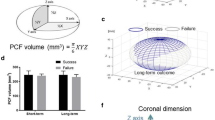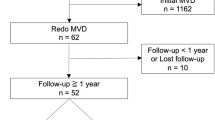Abstract
Background
A thorough observation of the root exit zone (REZ) and secure transposition of the offending arteries is crucial for a successful microvascular decompression (MVD) for hemifacial spasm (HFS). Decompression procedures are not always feasible in a narrow operative field through a retrosigmoid approach. In such instances, extending the craniectomy laterally is useful in accomplishing the procedure safely. This study aims to introduce the benefits of a skull base approach in MVD for HFS.
Methods
The skull base approach was performed in twenty-eight patients among 335 consecutive MVDs for HFS. The site of the neurovascular compression (NVC), the size of the flocculus, and the location of the sigmoid sinus are measured factors in the imaging studies. The indication for a skull base approach is evaluated and verified retrospectively in comparison with the conventional retrosigmoid approach. Operative outcomes and long-term results were analyzed retrospectively.
Results
The extended retrosigmoid approach was used for 27 patients and the retrolabyrinthine presigmoid approach was used in one patient. The measurement value including the site of NVC, the size of the flocculus, and the location of the sigmoid sinus represents well the indication of the skull base approach, which is significantly different from the conventional retrosigmoid approach. The skull base approach is useful for patients with medially located NVC, a large flocculus, or repeat MVD cases. The long-term result demonstrated favorable outcomes in patients with the skull base approach applied.
Conclusions
Preoperative evaluation for lateral expansion of the craniectomy contributes to a safe and secure MVD.








Similar content being viewed by others
References
Barker FG 2nd, Jannetta PJ, Bissonette DJ, Shields PT, Larkins MV, Jho HD (1995) Microvascular decompression for hemifacial spasm. J Neurosurg 82:201–210
Jannetta PJ (1975) The cause of hemifacial spasm: definitive microsurgical treatment at the brainstem in 31 patients. Trans Sect Otolaryngol Am Acad Ophthalmol Otolaryngol 80:319–322
Jannetta PJ, Abbasy M, Maroon JC, Ramos FM, Albin MS (1977) Etiology and definitive microsurgical treatment of hemifacial spasm. Operative techniques and results in 47 patients. J Neurosurg 47:321–328
Mercier P, Sindou M (2018) The conflicting vessels in hemifacial spasm: literature review and anatomical-surgical implications. Neurochirurgie 64:94–100
Sindou M, Mercier P (2018) Microvascular decompression for hemifacial spasm: Surgical techniques and intraoperative monitoring. Neurochirurgie 64:133–143
Sindou M, Mercier P (2018) Microvascular decompression for hemifacial spasm: outcome on spasm and complications. a review. Neurochirurgie 64:106–116
Ojemann RG (2001) Retrosigmoid approach to acoustic neuroma (vestibular schwannoma). Neurosurgery 48:553–558
Zhang KW, Shun ZT (1995) Microvascular decompression by the retrosigmoid approach for idiopathic hemifacial spasm: experience with 300 cases. Ann Otol Rhinol Laryngol 104:610–612
Bigder MG, Kaufmann AM (2016) Failed microvascular decompression surgery for hemifacial spasm due to persistent neurovascular compression: an analysis of reoperations. J Neurosurg 124:90–95
Liebelt BD, Huang M, Britz GW (2018) A comparison of cerebellar retraction pressures in posterior fossa surgery: extended retrosigmoid versus traditional retrosigmoid approach. World Neurosurg 113:e88–e92
Quiñones-Hinojosa A, Chang EF, Lawton MT (2006) The extended retrosigmoid approach: an alternative to radical cranial base approaches for posterior fossa lesions. Neurosurgery 58:208–214
Raza SM, Quinones-Hinojosa A (2011) The extended retrosigmoid approach for neoplastic lesions in the posterior fossa: technique modification. Neurosurg Rev 34:123–129
Alonso F, Dekker SE, Wright J, Wright C, Alonso A, Carmody M, Tubbs RS, Bambakidis NC (2017) The retrolabyrinthine presigmoid approach to the anterior cerebellopontine region: expanding the limits of trautmann triangle. World Neurosurg 104:180–185
Borghei-Razavi H, Shibao S, Schick U (2015) Anatomical variations of the presigmoid suprabulbar infralabyrinthine approach. Neurosurgery 76:E242-243
Rassi MS, Zamponi JO Jr, Cândido DNC, Oliveira JG, Passos GAR, Borba LAB (2018) Combined presigmoid and retrosigmoid approach to petroclival meningiomas. J Neurol Surg B Skull Base 79:S402–S403
Troude L, Baucher G, Lavieille JP, Roche PH (2021) The presigmoid retrolabyrinthine approach: Technical note. Neurochirurgie 67:503–507
De Ridder D, Menovsky T (2007) Neurovascular compression of the abducent nerve causing abducent palsy treated by microvascular decompression. Case report J Neurosurg 107:1231–1234
Wiet RJ, Schramm DR, Kazan RP (1989) The retrolabyrinthine approach and vascular loop. Laryngoscope 99:1035–1039
Inoue T, Hirai H, Shimizu T, Tsuji M, Shima A, Suzuki F, Matsuda M (2012) Ocular neuromyotonia treated by microvascular decompression: usefulness of preoperative 3D imaging: case report. J Neurosurg 117:1166–1169
Thirumala PD, Altibi AM, Chang R, Saca EE, Iyengar P, Reddy R, Anetakis K, Crammond DJ, Balzer JR, Sekula RF (2020) The utility of intraoperative lateral spread recording in microvascular decompression for hemifacial spasm: a systematic review and meta-analysis. Neurosurgery 87:E473–E484
Mintelis A, Sameshima T, Bulsara KR, Gray L, Friedman AH, Fukushima T (2006) Jugular tubercle: Morphometric analysis and surgical significance. J Neurosurg 105:753–757
Inoue T, Shitara S, Goto Y, Arham A, Prasetya M, Radcliffe L, Fukushima T (2021) Bridge technique for hemifacial spasm with vertebral artery involvement. Acta Neurochir (Wien) 163:3311–3320
Inoue T, Shitara S, Shima A, Goto Y, Fukushima T (2021) Double collagen matrix grafting for dural closure in microvascular decompression: an alternative use of autologous fascial grafting. Acta Neurochir (Wien) 163:2395–2401
Bejjani GK, Sekhar LN (1997) Repositioning of the vertebral artery as treatment for neurovascular compression syndromes. Technical note J Neurosurg 86:728–732
Huang J, Zhan Y, Li Y, Jiang L, Wang K, Wu Z, Xie Y, Shi Q (2021) The efficacy and safety of <2 cm micro-keyhole microvascular decompression for hemifacial spasm. Front Surg 28:685155
Kim EY, Park HS, Kim JJ, Lee SC, Ha CK, Park HC (2001) A more basal approach in microvascular decompression for hemifacial spasm: the para-condylar fossa approach. Acta Neurochir (Wien) 143:141–144
Shimizu K, Matsumoto M, Wada A, Mizutani T (2015) Lateral basal approach with a supine, no-retractor method for microvascular decompression for hemifacial spasm. Acta Neurochir (Wien) 157:803–806
Feng BH, Zhong WX, Li ST, Wang XH (2020) Fully endoscopic microvascular decompression of the hemifacial spasm: our experience. Acta Neurochir (Wien) 162:1081–1087
Flanders TM, Blue R, Roberts S, McShane BJ, Wilent B, Tambi V, Petrov D, Lee JYK (2018) Fully endoscopic microvascular decompression for hemifacial spasm. J Neurosurg 13:813–819
McGahan BG, Albonette-Felicio T, Kreatsoulas DC, Magill ST, Hardesty DA, Prevedello DM (2021) Simultaneous endoscopic and microscopic visualization in microvascular decompression for hemifacial spasm. Oper Neurosurg (Hagerstown) 21:540–548
Attabib N, Kaufmann AM (2007) Use of fenestrated aneurysm clips in microvascular decompression surgery. Technical note and case series. J Neurosurg 106:929–931
Ichikawa T, Agari T, Kurozumi K, Maruo T, Satoh T, Date I (2011) “Double-stick tape” technique for transposition of an offending vessel in microvascular decompression: technical case report. Neurosurgery 68:377–382
Jha RT, Kumar J, Pressman E, Agazzi S (2019) Arterial sling decompression for hemifacial spasm. World Neurosurg 132:134
Kim JY, Jung S, Song TW, Kim IY, Moon KS, Jung TY, Jang WY (2019) The cornerstone technique of microvascular decompression for hemifacial spasm with vertebral artery offender. World Neurosurg 126:e94–e100
Masuoka J, Matsushima T, Kawashima M, Nakahara Y, Funaki T, Mineta T (2011) Stitched sling retraction technique for microvascular decompression: procedures and techniques based on an anatomical viewpoint. Neurosurg Rev 34:373–379
Nonaka Y, Hayashi N, Matsumae M, Fukushima T (2019) Wedge-technique for transposition of the vertebral artery in microvascular decompression for hemifacial spasm: technical nuances and surgical outcomes. Acta Neurochir (Wien) 161:1435–1442
Rawlinson JN, Coakham HB (1988) The treatment of hemifacial spasm by sling retraction. Br J Neurosurg 2:173–178
Lin J, Zhang Y, Peng R, Ji X, Luo G, Luo W, Wang M, Zhu M, Sun X, Zhang Y (2019) Preoperative imaging and microscopic navigation during surgery can avoid unnecessarily opening the mastoid air cells through craniotomy using the retrosigmoid approach. World Neurosurg 121:e15–e21
Acknowledgements
We thank Ms. Satomi Fujimura, Ms. Yasuko Noda, and Ms. Kayoko Kutsuwa for their assistance with data collection and illustrations.
Author information
Authors and Affiliations
Corresponding author
Ethics declarations
Ethical approval
All procedures performed in studies involving human participants were in accordance with the ethical standards of the institutional and/or national research committee and with the 1964 Helsinki declaration and its later amendments or comparable ethical standards.
Informed consent
Informed consent was obtained from all individual participants included in the study.
Conflict of interest
.The authors declare no competing interests.
Additional information
Publisher's note
Springer Nature remains neutral with regard to jurisdictional claims in published maps and institutional affiliations.
Rights and permissions
Springer Nature or its licensor (e.g. a society or other partner) holds exclusive rights to this article under a publishing agreement with the author(s) or other rightsholder(s); author self-archiving of the accepted manuscript version of this article is solely governed by the terms of such publishing agreement and applicable law.
About this article
Cite this article
Inoue, T., Goto, Y., Shitara, S. et al. Indication for a skull base approach in microvascular decompression for hemifacial spasm. Acta Neurochir 164, 3235–3246 (2022). https://doi.org/10.1007/s00701-022-05397-2
Received:
Accepted:
Published:
Issue Date:
DOI: https://doi.org/10.1007/s00701-022-05397-2




